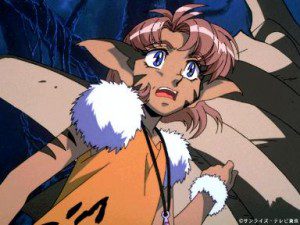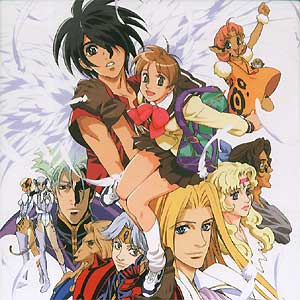 Modern day fans of anime take a lot of things for granted. Like access. While today it’s a simple matter to just log online and visit sites like Hulu and Crunchyroll to sate a fix for some animated goodness, back in the day it was a bit harder. Especially when television was the main outlet of consumption, and you were at the mercy of whatever Toonami or the *shudder* FoxBox decided to air. And doubly so if you were a fan of a particular genre of anime.
Modern day fans of anime take a lot of things for granted. Like access. While today it’s a simple matter to just log online and visit sites like Hulu and Crunchyroll to sate a fix for some animated goodness, back in the day it was a bit harder. Especially when television was the main outlet of consumption, and you were at the mercy of whatever Toonami or the *shudder* FoxBox decided to air. And doubly so if you were a fan of a particular genre of anime.
Back in the late 90s, this was the case for the budding mecha fan I was becoming. I knew of Gundam Wing, and through that a bit of the Gundam franchise, but I was blissfully ignorant of the rest of the wide world of giant robots, heroes and damsels, and wars to end all wars. So it made sense that I would be drawn to Wing for its military overtones, interesting characters and flashy battle sequences. And when I was done with Wing, I had few options save to watch it again.
And then I discovered Escaflowne. While casually flipping through Saturday morning cartoons, trying to find something to watch for the next hour or two, I landed on Fox of all channels and caught the openings minutes of something with giant robots, knights, dragons and some girl caught in the middle. That was all I really needed to get hooked.
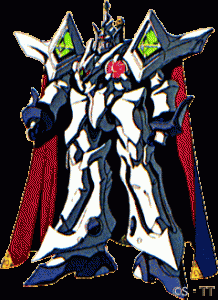 Vision of Escaflowne was the second mecha series I ever watched, and from the outset I knew it would bare minimal resemblance to Gundam Wing. No clusters of pretty-boy pilots (but more than a few bishounen badasses), no politically savvy young heroines or eccentric scientists with axes to grind and mountains of invulnerable metal to work with. Oppressive regimes were there, but they’re part of every mecha franchise when you think about it. And the suit designs, a mix of old medieval armor with some modern edges, were close enough to angels and shinigami for me to appreciate them. But that was about as close to the mecha I was used to as it got.
Vision of Escaflowne was the second mecha series I ever watched, and from the outset I knew it would bare minimal resemblance to Gundam Wing. No clusters of pretty-boy pilots (but more than a few bishounen badasses), no politically savvy young heroines or eccentric scientists with axes to grind and mountains of invulnerable metal to work with. Oppressive regimes were there, but they’re part of every mecha franchise when you think about it. And the suit designs, a mix of old medieval armor with some modern edges, were close enough to angels and shinigami for me to appreciate them. But that was about as close to the mecha I was used to as it got.
Escaflowne is rather unique in its interpretation and storytelling, preferring to take only minimal science fiction elements while weaving a complex world that would feel more at home in an old Squaresoft game, or someone’s low-tech Dungeons and Dragons campaign. While mobile suits exist, they are few and far between on the mystic moon of Gaea, and those that do exist outside of the powerfully advanced Zaibach Empire are prized above any other weapon. And make no mistake, these suits, called Guymelefs, are little more than fancy suits or armor used exclusively for combat…at least when the series begins.
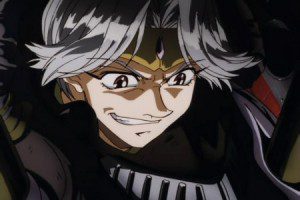
The delicate balance of nations on the mystic moon becomes threatened when the Zaibachs, borrowing a page from pretty much every other “big mecha baddie” on record, decide to conquer the entirety of Gaea. And, fitting the notion that they alone deserve to rule, they have the best suits, the most ruthless pilots and the biggest military, easily crushing the other nations and forcing pledges of fealty from defeated rulers. Anyone currently watching Game of Thrones could appreciate the ruthlessness of the Zaibachs, draw parallels between the subtle politics of betrayal and honor, and throw support behind the hopelessly outmatched kingdoms of Gaea as one by one they are overwhelmed and subjugated.
At the same time, Escaflowne draws heavily from mysticism and magic, presenting an interesting blend of old world Tibetan mythology with the divining tools of the Tarot. On Gaea, card readings have power, even influencing the outcome of events, and revealing the nature of upcoming conflicts. Honor and duty are put into stark contrast as plot developments introduce new characters, explain relationships of older characters, and force hard decisions to be made, often with only a vague notion of the consequences.
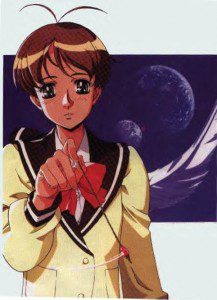 At the middle of this milieu is the stranded Hitomi, a resident of Earth, pulled into Gaea when a dragon attacks her school. Hitomi has visions, knows the cards well, and serves as the linchpin holding the fragmented resistance forces together. As an outsider, she sees and experiences things the residents of Gaea take for granted, and offers as much help as any “mundane” human can, powerless as she is in the face of warring kingdoms, political subterfuge and matters of the heart. While not the sole “human” member of the cast, much of what the viewer sees and understands comes through Hitomi’s eyes- she has to struggle to accept a world far different from her own, while trying her hardest not to stand out, despite being the stranger in the room. Her need to balance conflicting emotions while still remaining as level-headed as possible is something any viewer can relate to, and in turn grants her more sympathy than an Asuke or a Relena. She is both the odd-girl-out and the every-girl, occupying two very different, yet challenging positions at the same time.
At the middle of this milieu is the stranded Hitomi, a resident of Earth, pulled into Gaea when a dragon attacks her school. Hitomi has visions, knows the cards well, and serves as the linchpin holding the fragmented resistance forces together. As an outsider, she sees and experiences things the residents of Gaea take for granted, and offers as much help as any “mundane” human can, powerless as she is in the face of warring kingdoms, political subterfuge and matters of the heart. While not the sole “human” member of the cast, much of what the viewer sees and understands comes through Hitomi’s eyes- she has to struggle to accept a world far different from her own, while trying her hardest not to stand out, despite being the stranger in the room. Her need to balance conflicting emotions while still remaining as level-headed as possible is something any viewer can relate to, and in turn grants her more sympathy than an Asuke or a Relena. She is both the odd-girl-out and the every-girl, occupying two very different, yet challenging positions at the same time.
Knights become dragons, heroes fight and die, and kingdoms rise and fall as the series veers off from the usual tropes and ventures into high fantasy and adventure, while still maintaining a swift pace that easily suits marathoning episodes. And then it ends, leaving the viewer with a mix of emotion and satisfaction, and a yearning for more. Vision of Escaflowne is an interesting entry into the giant robot genre, to say the least, because it chooses to eschew those tropes and embrace new ideas. While this might seem more commonplace in the modern arena of anime series, at the time this was still largely untested water, especially when licensing the show for US audiences. And, despite some of the heavy criticism leveled at Fox for “butchering” the content and producing a “questionable” dub, the show holds up remarkable well 15 years after its first airing- something many other series of its time have trouble doing.
So if you are ever in the market for something old-school, with 90s animation, an interesting narrative and plenty of action, Vision of Escaflowne is a worthy choice. You will not be disappointed.
